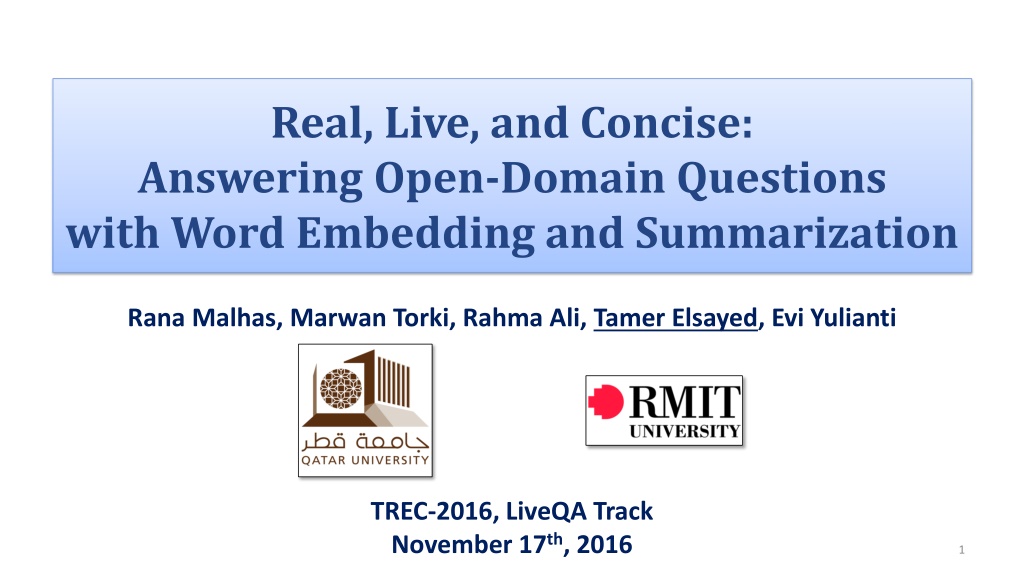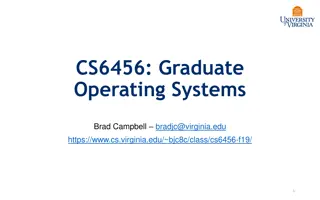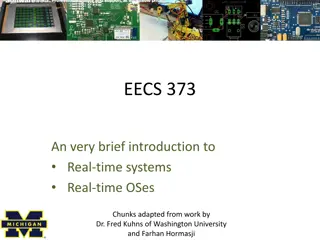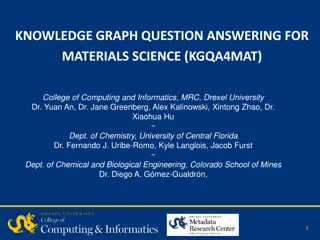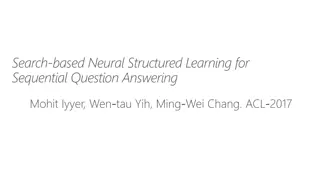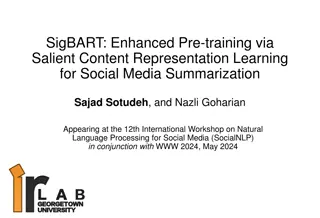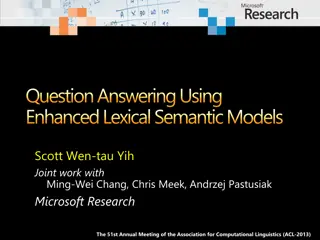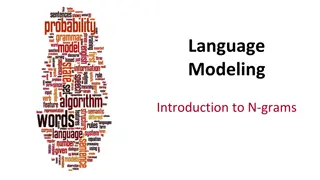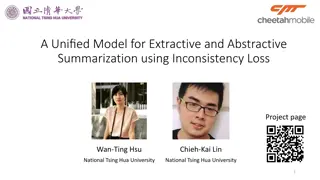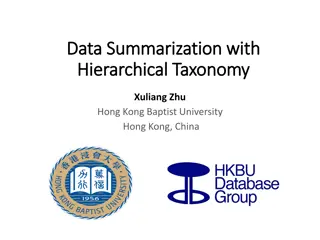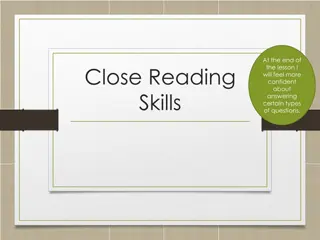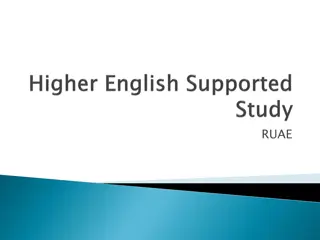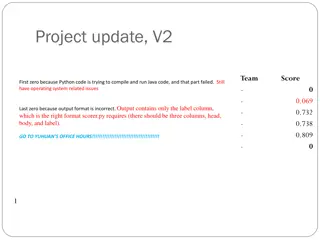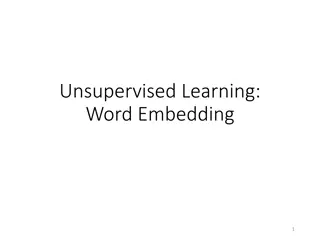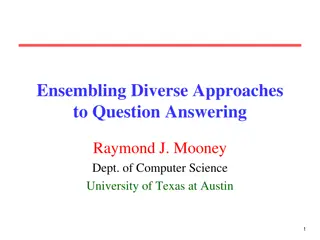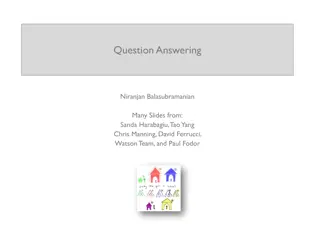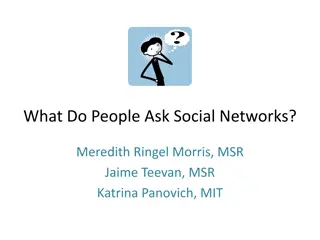Real-time Question Answering Using Word Embedding and Summarization Techniques
This research project aims to improve question answering over social media platforms by leveraging word embedding and summarization methods. The approach involves retrieving a large set of candidate answers from various sources, learning to rank these answers, and summarizing the top-ranked ones. Techniques such as extractive summarization at the sentence level are employed to enhance the quality of responses. The system also utilizes pre-trained models like GloVE for feature extraction and learning to rank. By focusing on real-time systems and addressing past performance issues, the project seeks to enhance the efficacy of open-domain question answering.
Download Presentation

Please find below an Image/Link to download the presentation.
The content on the website is provided AS IS for your information and personal use only. It may not be sold, licensed, or shared on other websites without obtaining consent from the author. Download presentation by click this link. If you encounter any issues during the download, it is possible that the publisher has removed the file from their server.
E N D
Presentation Transcript
Real, Live, and Concise: Answering Open-Domain Questions with Word Embedding and Summarization Rana Malhas, Marwan Torki, Rahma Ali, Tamer Elsayed, Evi Yulianti TREC-2016, LiveQA Track November 17th, 2016 1
Why? Interested in QA over social media Interested in live and real-time systems Because we did very poorly last year! 2
3 Key Ideas of Our Approach Retrieve enough/large set of candidate answers Leverage multiple sources Learn how to rank retrieved answers Try new features Summarize top-ranked answers Extractive at the sentence level 3
Answer Retrieval Answer Retrieval Q incoming question Google Search Bing Search YA! Search aggregated answers candidate answers candidate answers A A A A Live API search Archived index of 16.9M Qs (2013-2016) Live scrapping of search results Snippets of top 5 Question-Question similarity Best answers of top 5 Snippets of top 5 4
Learning How to Rank Answers pre-trained GloVE model Feature Extraction TREC 15 QRELS (training data) MK features Cov features Covariance of word embedding dimensions of GloVE vectors Metzler-Kanungo: answer length exact match term overlap LM score 5
??= ????(??) ??????????? ?????? (??) ???????? ???? ???? ???_???? 1 ???_???? 1 ?????????? ???????? ???_???? 2 ???_???? 2 ???_???? 3 ???_???? 3 Document(??) Question-QA Pair Compute Covariance Matrix ?? Lookup Word Embedding Model Document Pre- Processing Vectorize ?? ???_?????_? ???_???? ?_? Learned Word Embedding Model voc_term 1 voc_term 2 Un-labeled Document Collection voc_term 3 Learn Word Embedding voc_term V 6
Learning How to Rank Answers pre-trained GloVE model features Feature Extraction Learning to Rank TREC 15 QRELS (training data) answer ranking model MK features Cov features MART (Multiple Additive Regression Trees) Covariance of word embedding dimensions of GloVE vectors Metzler-Kanungo: answer length exact match term overlap LM score prediction model in the form of an ensemble of weak prediction models 7
Live System Answer Retrieval Q incoming question Google Search Bing Search YA! Search aggregated answers candidate answers candidate answers Extractive summary of top 3 ranked answers. Works at sentence level Model solves maximum coverage problem where coverage of important terms is maximized while redundancy is minimized. Transformed into a linear programming problem. A A A A pre-trained GloVE model answer ranking model Answer Ranking Feature Extraction features A Ranking Summarization A ranked answers returned answer 8
Experimental Setup Training data: TREC 2015 QRELs Used RankLib for L2R 5-fold cross validation used MAP as the objective function 9
Pre-TREC L2R Experiments Feature Set Features MAP with 5-Fold CV 4 features MK 0.4705 MK + Cov-50D 0.3180 MK + Cov MK + Cov-100D 0.3260 Model trained over MK features only outperformed other models! High dimensionality in covariance word embedding features didn t contribute much given increasing space and time complexities 10
Submitted Runs Sources Only Every Thing Simple QU2 QU3 QU YA!+Bing+Google MK + Cov MART L2R Summarizer YA!+Bing+Google MK + Cov MART L2R Summarizer YA!+Bing+Google MK + Cov MART L2R Summarizer 11
Official Results Sources Only 0.7842 Evaluation Measure AvgScore (0-3) succ@2+ succ@3+ succ@4+ prec@2+ prec@3+ prec@4+ 0.4236 0.2532 0.1074 0.4419 0.2641 0.1120 Questions Answered 973 12
Official Results Sources Only 0.7842 Every Thing 0.8768 0.4670 0.2956 0.1143 0.5011 0.3171 0.1226 Evaluation Measure AvgScore (0-3) succ@2+ succ@3+ succ@4+ prec@2+ prec@3+ prec@4+ 0.4236 0.2532 0.1074 0.4419 0.2641 0.1120 Questions Answered 973 946 13
Official Results Sources Only 0.7842 Every Thing 0.8768 Evaluation Measure Simple AvgScore (0-3) 0.9005 0.4631 0.2975 0.1399 0.4667 0.2999 0.1410 succ@2+ succ@3+ succ@4+ prec@2+ prec@3+ prec@4+ 0.4236 0.2532 0.1074 0.4419 0.2641 0.1120 0.4670 0.2956 0.1143 0.5011 0.3171 0.1226 Questions Answered 973 946 1007 14
Official Results Sources Only 0.7842 Every Thing 0.8768 Evaluation Measure Simple Track Average AvgScore (0-3) 0.5766 0.9005 0.4631 0.2975 0.1399 0.4667 0.2999 0.1410 succ@2+ succ@3+ succ@4+ prec@2+ prec@3+ prec@4+ 0.4236 0.2532 0.1074 0.4419 0.2641 0.1120 0.3042 0.1898 0.0856 0.3919 0.2429 0.108 0.4670 0.2956 0.1143 0.5011 0.3171 0.1226 Questions Answered 973 946 771.0385 1007 15
Sources of Returned Answers in Sources Only ! % Score Contribution 63% 10% 27% Answers Average score 0.7904 0.6712 0.7377 Bing Google YA! 609 92 273 17
Conclusion 3-stage QA system: answer retrieval, answer ranking and summarization MK features are very effective! Cov over Word Embeddings didn t prove itself (yet!) Relying on Web Search is risky! Ranked 4th among automatic runs! 18
Future Work Ablation study! Better ways to combine word embedding features with others Scalable answer retrieval (to avoid timeout problems) Apply L2R ot sentence level Learn when (not) to summarize 19
Thank You! 21
Question:Foot pain unable to walk? Answer: X-rays and other imaging tests (CT scans, MRIs) may be ordered if there are not obvious signs of an underlying cause, or if you are unable to put weight on your foot. Physical examinations may also reveal where the problem is located in the foot. Treatment Options for Your Foot Pain There are numerous things you can do to control or treat your foot pain. The first step is seeing a foot specialist, a podiatrist, or a foot and ankle surgeon. You can sometimes help yourself by using the acronym RICE to relieve foot pain. RICE stands for Rest, Ice, Compression, and Elevation. Sources Only Bing Question:Do you need an exotic animal permit to own a peacock? Answer: You need a licence to keep some animals, eg: wild cats primates wild dogs, eg wolves certain pigs, eg wild boar marsupials See the full list of animals you need a licence for. Hybrid or cross-bred animals may need a licence, depending on how far removed the animal is from its wild ancestor. If you re not sure, ask your local council. Every Thing Summary Question:Which is an example of the absolutism under peter the great? Answer: fighting the great northern war required unprecedented economic resources, and russia's yawning budget deficit and aging infrastructure meant that the state could not effectively allocate resources and money in wartime. peter's government was constantly in dire need of money, and at first it responded by monopolizing certain strategic industries, such as salt, alcohol, oak, and tar. peter also taxed many russian cultural customs (such as bathing, fishing, beekeeping, and wearing beards) and issued tax stamps for paper goods. however, with each new tax came new loopholes and new ways to avoid them, and so it became clear that tax reform was simply not enough. **the solution was a sweeping new poll tax, which replaced a household tax on cultivated land. previously, peasants had skirted the tax by combining several households into one estate; now, however, each peasant was assessed individually for a tax of 70 kopeks, paid in cash. Simple YA! 22
